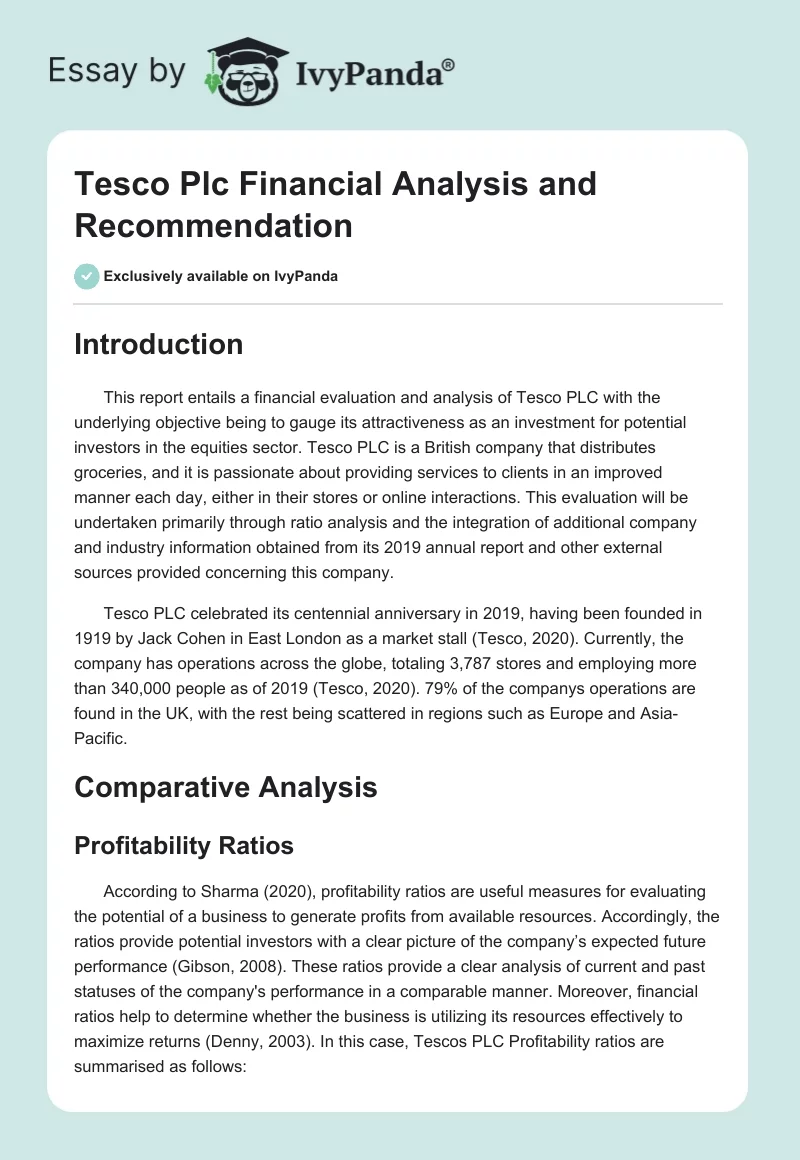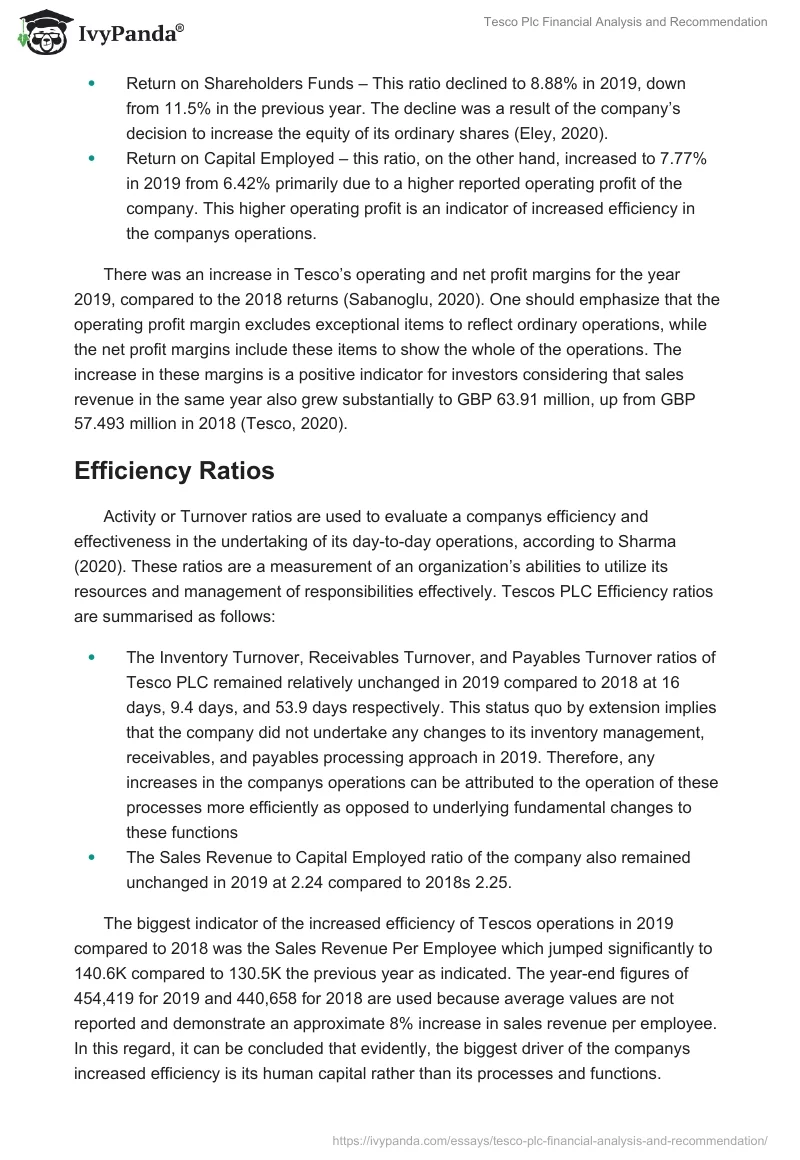Introduction
This report entails a financial evaluation and analysis of Tesco PLC with the underlying objective being to gauge its attractiveness as an investment for potential investors in the equities sector. Tesco PLC is a British company that distributes groceries, and it is passionate about providing services to clients in an improved manner each day, either in their stores or online interactions. This evaluation will be undertaken primarily through ratio analysis and the integration of additional company and industry information obtained from its 2019 annual report and other external sources provided concerning this company.
Tesco PLC celebrated its centennial anniversary in 2019, having been founded in 1919 by Jack Cohen in East London as a market stall (Tesco, 2020). Currently, the company has operations across the globe, totaling 3,787 stores and employing more than 340,000 people as of 2019 (Tesco, 2020). 79% of the companys operations are found in the UK, with the rest being scattered in regions such as Europe and Asia-Pacific.
Comparative Analysis
Profitability Ratios
According to Sharma (2020), profitability ratios are useful measures for evaluating the potential of a business to generate profits from available resources. Accordingly, the ratios provide potential investors with a clear picture of the company’s expected future performance (Gibson, 2008). These ratios provide a clear analysis of current and past statuses of the company’s performance in a comparable manner. Moreover, financial ratios help to determine whether the business is utilizing its resources effectively to maximize returns (Denny, 2003). In this case, Tescos PLC Profitability ratios are summarised as follows:
- Return on Shareholders Funds – This ratio declined to 8.88% in 2019, down from 11.5% in the previous year. The decline was a result of the company’s decision to increase the equity of its ordinary shares (Eley, 2020).
- Return on Capital Employed – this ratio, on the other hand, increased to 7.77% in 2019 from 6.42% primarily due to a higher reported operating profit of the company. This higher operating profit is an indicator of increased efficiency in the companys operations.
There was an increase in Tesco’s operating and net profit margins for the year 2019, compared to the 2018 returns (Sabanoglu, 2020). One should emphasize that the operating profit margin excludes exceptional items to reflect ordinary operations, while the net profit margins include these items to show the whole of the operations. The increase in these margins is a positive indicator for investors considering that sales revenue in the same year also grew substantially to GBP 63.91 million, up from GBP 57.493 million in 2018 (Tesco, 2020).
Efficiency Ratios
Activity or Turnover ratios are used to evaluate a companys efficiency and effectiveness in the undertaking of its day-to-day operations, according to Sharma (2020). These ratios are a measurement of an organization’s abilities to utilize its resources and management of responsibilities effectively. Tescos PLC Efficiency ratios are summarised as follows:
- The Inventory Turnover, Receivables Turnover, and Payables Turnover ratios of Tesco PLC remained relatively unchanged in 2019 compared to 2018 at 16 days, 9.4 days, and 53.9 days respectively. This status quo by extension implies that the company did not undertake any changes to its inventory management, receivables, and payables processing approach in 2019. Therefore, any increases in the companys operations can be attributed to the operation of these processes more efficiently as opposed to underlying fundamental changes to these functions
- The Sales Revenue to Capital Employed ratio of the company also remained unchanged in 2019 at 2.24 compared to 2018s 2.25.
The biggest indicator of the increased efficiency of Tescos operations in 2019 compared to 2018 was the Sales Revenue Per Employee which jumped significantly to 140.6K compared to 130.5K the previous year as indicated. The year-end figures of 454,419 for 2019 and 440,658 for 2018 are used because average values are not reported and demonstrate an approximate 8% increase in sales revenue per employee. In this regard, it can be concluded that evidently, the biggest driver of the companys increased efficiency is its human capital rather than its processes and functions.
Liquidity Ratios
According to Sharma (2020), liquidity ratios help to assess the financial capacity of a business to meet short-term obligations, such as debts, when they are due. High liquidity ratios indicate that the business is not at risk of bankruptcy, since it can easily pay off creditors (Coulon, 2019). Tescos liquidity ratios for 2019 are as summarised below:
- The Current Ratio, Acid Test Trae, and the Cash generated from operations to maturing obligations ratio all declined marginally to 0.61, 0.48, and 0.13 in 2019 respectively. In the previous year, these ratios respectively stood at 0.71, 0.59, and 0.17.
- The decline in these ratios is attributed to an increase in the companys Current Liabilities to GBP 20,680 Million compared to GBP 19,233 Million in 2018. Current Assets also declined marginally from GBP 13,600 Million in 2019 compared to GBP 12,570 Million in 2018.
- The decline in Current Assets is partly attributed to a decrease in the companys cash reserves of GBP 2,916 Million in 2019 compared to GBP 4,056 Million in 2018 (Tesco, 2020).
- Despite these marginal declines, the company’s liquidity ratios all remain in a healthy position indicating that it can comfortably meet its short-term obligations in the future.
Gearing Ratios
Gearing Ratios are used to evaluate a companys level of indebtedness and the use of Financial Leverage in the financing of the company’s operations and within its capital structure (Sharma, 2020). Tescos PLC Gearing ratios are summarised as follows:
- Gearing Ratio – Tescos Gearing Ratio in 2019 signified a massive improvement to 59.1% compared to 47.7% the previous year. This improvement was attributed directly to the decline in the companys Long term liabilities, a positive indicator to potential investors of the company as per the analysis.
- The reduction in the companys long-term liabilities may also explain the previously observed decline in the companys cash reserves. Accordingly, Tesco PLC utilized part of its cash reserves to cover its long-term obligations in the financial year ending 2019.
- Interest Cover Ratio – Tescos Interest Cover also increased significantly to 4.1 in 2019 from 2.7 the previous year. This increase is attributed to many factors, including the companys growth in its operating profit during this financial period.
Investment Ratios
Investment Ratios are used to evaluate the returns earned or attributable to the investors in a companys shares over a given time duration, usually one financial period or so depending on the company setup (Larrabee and Voss, 2012). Tescos PLC Investment ratios are summarised as follows:
- Dividend Payout Ratio – Tescos Dividend Payout Ratio increased from 25% in 2018 to 37% in 2019, with dividends paid increasing substantially from 3.0p to 5.77p during the same period.
- Dividend Cover Ratio – this ratio declined from 4.0 to 2.7 in 2019 due to the increased dividends paid out by Tesco 2019.
- The Dividend Yield Ratio increased significantly from 1.5% to 2.6% in 2019, underpinned by a higher dividend payout by the company. Within the same financial period, the companys Market Value Per Share also increased to 222.8p from 205.4p, subsequently resulting in the lower Dividend Yield Ratio.
- Earnings Per Share – Tescos EPS also increased in 2019 to 15.4p from 11.9p the previous year due to the higher dividends paid out.
- Tesco’s P/E (price to earnings) declined slightly, down from 17.3 in 2018 to 14.5 in 2019, as a result of the increase in the companys share value, and the corresponding increase in its earnings per share.
Recommendations and Conclusions
The analysis of Tesco PLCs performance in 2019 compared to 2018 based on financial ratios indicates that the company significantly increased its operating efficiency as evidenced by different measures such as its Turnover Ratios (Tesco, 2020). During this period, the company also intentionally sought to drive down its operating costs as shown in its annual report, which in the event significantly increased its operating efficiency.
Increasing sales and profit margins by extension have yielded an increase in the companys Dividend Payout, which is a significantly attractive proposition for potential investors in the business. Consequently, increased dividends have also led to an increase in the Market Value per share of the companys stock upwards resulting in increased Investment Ratios of the company.
The corresponding reduction in Tesco’s long-term liabilities further points to both the companys solvency and its increased attractiveness to potential equity investors (Wood, 2020). The companys P/E ratio is higher than that of its competitors, implying that it is its operating strategy that is driving the increase in value and not macro-level or industry factors. Based on the above considerations and the expected rise in Tesco PLCs value as it continues to roll out its turnaround plan, it is recommended that potential investors should Buy and Hold the companys shares over a mid to long-term horizon.
According to Epstein and Buhovac (2014), some external factors would impact the strategy of the company, which would be of great interest to potential investors. These factors include customers or target groups, the inputs from supplies, business competitors, media effects, political sways, technological advances, economic, social, and natural phenomena.
Limitations of Ratio Analysis
Ratio analysis is prone to several limitations which may impact its effectiveness as an analytical tool. In this regard, the first limitation of financial ratio analysis is its dependence on historical data, thereby lacking a forward-looking perspective in the output information of these ratios (Tracy, 2012). Secondly, financial ratio analysis does not factor in external influences, which impact a companys operations, such as the underlying macro-level factors (Lee, 2007). Thirdly, financial ratio analysis also fails to consider the impact of a companys human capital which is its most important resource to be included in the process.
Reference List
Coulon, Y. (2019) Rational investing with ratios: implementing ratios with enterprise value and behavioral finance. New York: Spring Nature.
Denny, R.S. (2003) Accounts for solicitors. New York: Psychology Press.
Eley, J. (2020) ‘Tesco defends payouts amid warnings over profit hits from coronavirus‘, Financial Times, Web.
Epstein, M. J., & Buhovac, A. R. (2014). Making sustainability work: best practices in managing and measuring corporate social, environmental, and economic impacts. New York: Berrett-Koehler Publishers.
Gibson, C. (2008) Financial reporting and analysis: using financial accounting information. 11th edn. New York: Cengage Learning.
Larrabee, D.T and Voss, J. A. (2012) Valuation techniques: discounted cash flow, earnings quality, measures of value added, and real options. New York: John Wiley & Sons.
Lee, T.A. (2007). Financial reporting and corporate governance. New York: John Wiley & Sons.
Sabanoglu, T. (2020) ‘Tesco group revenue in the United Kingdom (UK) 2015-2020’, Statista, Web.
Sharma, R. J. (2020) Ratio analysis: financial ratios. New Jersey: Amazon Digital Services.
Tesco. (2020) About. Web.
Tracy, A. (2012) Ratio analysis fundamentals: how 17 financial ratios can allow you to analyze any business on the planet. New York: RatioAnalysis.net.
Wood, Z. (2020) ‘Tesco defends £315m dividend plan despite business rates holiday’, The Guardian, Web.
Tesco Plc’s Annual Report, 2019. Web.



